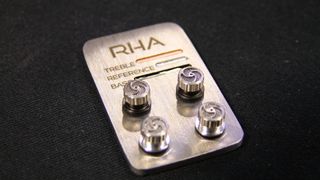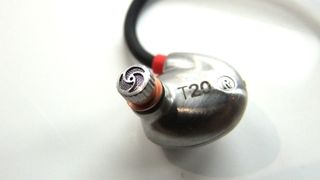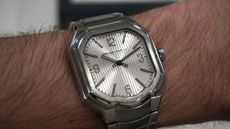People like Beats headphones. It's a fact and, as much as we might bemoan the style-over-content ethos, Beats' impact on the premium headphone market can't be ignored. They're like the gateway-drug for high-end headphones.
The RHA T20 headphones are Reid and Heath Acoustics' next shot at the premium in-ear market. It's first go, the T10i headphones, were reasonably successful if a little over-excitable on the bass front. But RHA is aiming to right the previous design's few wrongs with its new design.
The T20s though are still obviously related to their progenitors, using the same injection-moulded metal housing to lend them that real high-end feel, and also come with the most obvious selling point of the T10i: the tuneable filters.

When you're spending pretty big on a pair of in-ear headphones - and at £180 for the T20s you will be - you want to know they are going to be versatile enough to cope with your varied music tastes.
While you might go through phases of listening to a very specific genre of music, chances are you'll be listening intently to one type of music today and something tonally very different the next month. My personal tastes happily bounce between the likes of John B, Palma Violets, Dire Straits, The Cure and Emancipator - all pretty different and all really demanding different things for your headphones.
That's where RHA's changeable filters, smart driver design and relatively wide frequency range come into their own.
The default set of screw-on filters are the most balanced, offering an almost reference-level, flat EQ, but there are also discrete sets to filter out more bass or more treble. They're easy to change - remove the ear-tip and simply unscrew the existing filter and replace it.

Though, realistically, they're a little too fiddly for you to able to change on the fly when you're out and about.
Comfort and fit
There are also myriad different ear-tips too, from standard single and dual-flange silicone designs to differently-sized memory foam options. These all make it very easy to find a comfortable, and impressively noise-cancelling, fitting with the T20s.
What might be a little more divisive though is the over-ear hook design, where the cable itself wraps up-and-over the ear. The top part of the rubberised headphone cable has its own memory, retaining its shape when wound around your ears.
This stops them from being easily tugged out of your ear and also stops them from feeling too weighty. That moulded metal design could have felt very heavy on the ear otherwise. Though that weight does give a real sense of their build-quality.

As does the stainless steel splitter which parts the hefty multicore cable and splits it between left and right components. The 3.5mm headphone jack is constructed from a similarly weighty chunk of steel, with a springy coil wrapped around the base of the cable to give it some support and - hopefully - a longer life.
Sound quality
All the design smarts and customisation would be for nought if the sound quality wasn't up to scratch. Thankfully this is where RHA has stepped up its game from the T10i headphones.
With the default filter set the audio is clear and precise, without the over-heavy bass which marred the previous design. The clarity on the vocals is seriously impressive making them a great choice if you have a penchant for accapella or audio books, but maybe less so for EDM or anything you want to have a little more punch.
For that though you can add the filter which emphasise low-end frequencies. This adds a definite depth to the sound without unnecessarily muddying the other frequencies.
I'm not sure where the other filter comes in though; it just makes the aural experience too lightweight and thin for my tastes.
It's not just all about these filters though, the main reason for the impressive sound quality is the DualCoil dynamic driver design, effectively integrating an additional tweeter into the space normally given over to a single driver design. And those filters are only of any use because the DualCoil drivers offer a broad frequency range going from 16Hz-40kHz.
This all helps give a balance to the audio which stops the T20s from being fatiguing to wear for long periods of time - something which I find happens a lot with other in-ear designs.
The sound quality in the T20s then makes them a great in-ear fit for the likes of Hi-Res Audio devices we're seeing coming from the likes of Pioneer with its new XDP-100R player, or higher-end options from Acoustic Research and Astell&Kern.

T3 Verdict
RHA's T20 headphones deliver a great sound and are impressively versatile too. They fix the unseemly bass levels which marred the original T10i design and deliver incredible clarity to acoustic and vocal performances.
They might seem a little feature-light for the smartphone crowd - though you can go for the T20i set which offers in-line controls if that is what you're after. That said there are no other in-ear sets out there which can offer the tuneable filters the T20 headphones come with.
They're not perfect - that over-ear loop is going to put a good few people off - but they do offer excellent sound coupled with robust build quality. And they're a set of headphones I keep coming back to when testing new Hi-Res Audio devices.


